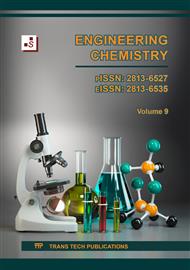[1]
A. Mokhtar, S. Abdelkrim, A. Djelad, A. Sardi, B. Boukoussa, M. Sassi, A. Bengueddach, Adsorption behavior of cationic and anionic dyes on magadiite-chitosan composite beads, Carbohydr Polym 229 (2020).
DOI: 10.1016/j.carbpol.2019.115399
Google Scholar
[2]
J. Geng, L. Lin, F. Gu, J. Chang, Adsorption of Cr(Ⅵ) and dyes by plant leaves: Effect of extraction by ethanol, relationship with element contents and adsorption mechanism, Ind Crops Prod 177 (2022).
DOI: 10.1016/J.INDCROP.2022.114522
Google Scholar
[3]
A. Mokhtar, B. Boukoussa, A. Baba Ahmed, S. Abdelkrim, A. Djelad, M. Hachemaoui, F. Zaoui, A. Bengueddach, M. Sassi, Alginate@Layered Silicate Composite Beads: Dye Elimination, Box–Behnken Design Optimization and Antibacterial Property, J Inorg Organomet Polym Mater 32 (2022) 2615–2633.
DOI: 10.1007/s10904-022-02350-9
Google Scholar
[4]
L.D. Pompeu, P.C.L. Muraro, G. Chuy, B.S. Vizzotto, G. Pavoski, D.C.R. Espinosa, L. da Silva Fernandes, W.L. da Silva, Adsorption for rhodamine b dye and biological activity of nano-porous chitosan from shrimp shells, Environ Sci and Pollut Res 29 (2022) 49858–49869.
DOI: 10.1007/s11356-022-19259-y
Google Scholar
[5]
A. Mokhtar, S. Abdelkrim, B. Boukoussa, M. Hachemaoui, A. Djelad, M. Sassi, M. Abboud, Elimination of toxic azo dye using a calcium alginate beads impregnated with NiO/activated carbon: Preparation, characterization and RSM optimization, Int J Biol Macromol 233 (2023).
DOI: 10.1016/j.ijbiomac.2023.123582
Google Scholar
[6]
N. Ali, A. Hameed, S. Ahmed, Physicochemical characterization and Bioremediation perspective of textile effluent, dyes and metals by indigenous Bacteria, J Hazard Mater 164 (2009) 322–328.
DOI: 10.1016/j.jhazmat.2008.08.006
Google Scholar
[7]
D.N. Poshina, S. V. Raik, A.N. Poshin, Y.A. Skorik, Accessibility of chitin and chitosan in enzymatic hydrolysis: A review, Polym Degrad Stab 156 (2018) 269–278.
DOI: 10.1016/j.polymdegradstab.2018.09.005
Google Scholar
[8]
P.O. Osifo, A. Webster, H. van der Merwe, H.W.J.P. Neomagus, M.A. van der Gun, D.M. Grant, The influence of the degree of cross-linking on the adsorption properties of chitosan beads, Bioresour Technol 99 (2008) 7377–7382.
DOI: 10.1016/j.biortech.2008.01.053
Google Scholar
[9]
G. Rojas, J. Silva, J.A. Flores, A. Rodriguez, M. Ly, H. Maldonado, Adsorption of chromium onto cross-linked chitosan, Sep Purif Technol 44 (2005) 31–36.
DOI: 10.1016/j.seppur.2004.11.013
Google Scholar
[10]
J. Kabuba, M. Banza, Ion-exchange process for the removal of Ni (II) and Co (II) from wastewater using modified clinoptilolite: Modeling by response surface methodology and artificial neural network, Results Eng 8 (2020).
DOI: 10.1016/j.rineng.2020.100189
Google Scholar
[11]
M. Banza, H. Rutto, T. Seodigeng, Application of Artificial Neural Network and Shrinking Core Model for Copper (Ii) and Lead (Ii) Leaching from Contaminated Soil Using Ethylenediaminetetraacetic Acid, Soil Sediment Contam (2023).
DOI: 10.1080/15320383.2023.2178384
Google Scholar
[12]
E. Igberase, P. Osifo, A. Ofomaja, Chromium (VI) ion adsorption by grafted cross-linked chitosan beads in aqueous solution–a mathematical and statistical modeling study, Environ Technol (United Kingdom) 38 (2017) 3156–3166. https://doi.org/10.1080/09593330. 2017.1290152.
DOI: 10.1080/09593330.2017.1290152
Google Scholar
[13]
C.E. Onu, J.T. Nwabanne, P.E. Ohale, C.O. Asadu, Comparative analysis of RSM, ANN and ANFIS and the mechanistic modeling in eriochrome black-T dye adsorption using modified clay, S Afr J Chem Eng 36 (2021) 24–42.
DOI: 10.1016/j.sajce.2020.12.003
Google Scholar


